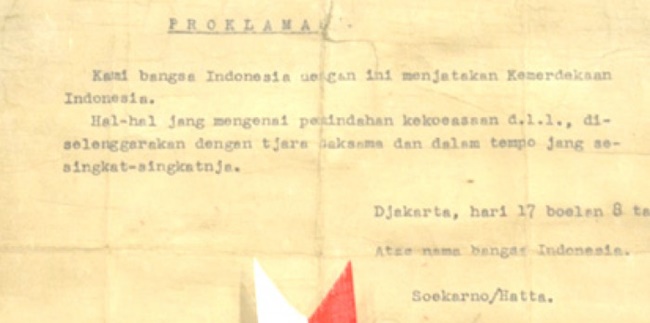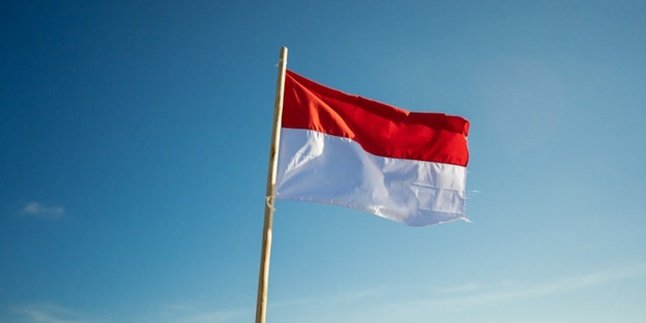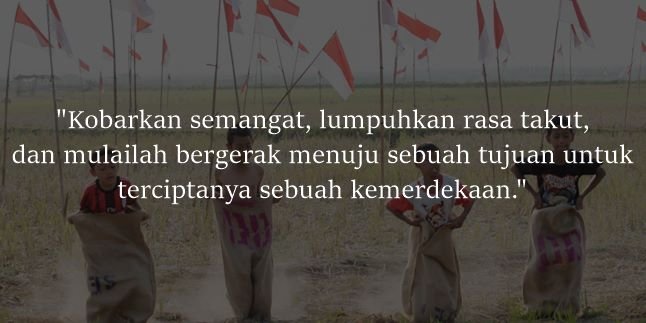Kapanlagi.com - The reading of the Indonesian independence proclamation text signifies that the Indonesian nation has officially declared itself independent from the colonizers. The Indonesian independence proclamation text was read by Soekarno accompanied by Mohammad Hatta on Friday, August 17, 1945 at 10:00 in front of the veranda of Soekarno's house, located at Jalan Pegangsaan Timur Number 56, Jakarta.
There are several important events or histories related to the preparation and formulation of the Indonesian proclamation text involving important figures from the older generation and the younger generation. The defeat of Japan against the allies in World War II became the momentum to declare Indonesian independence.
Finally, after going through a long process to immediately proclaim the independence of the Indonesian nation, the formulation and reading of the Indonesian independence proclamation text was officially carried out on August 17, which until now we commemorate as the Independence Day of the Republic of Indonesia.
Quoting from the Cagar Budaya website of the Ministry of Education and Culture, the Indonesian independence proclamation text written by Soekarno and typed by Sayuti Melik has several differences. Here's the review of the content of the Indonesian independence proclamation text along with its meaning that has been summarized by kapanlagi.com from various sources.
1. History of the Formulation of the Indonesian Independence Proclamation

(credit: unsplash.com)
A number of young figures, namely Sutan Sjahrir, Wikana, Darwis, and Chaerul Saleh, upon hearing Japan's defeat by the allies in World War II through the BBC radio, urged Soekarno and Moh.Hatta to immediately proclaim Indonesian independence. This was done so that the Indonesian people would not have to wait for Japan's promises to grant independence to Indonesia.
Finally, on August 16, 1945, preparations for formulating and drafting the text of the proclamation of Indonesian independence began. A group of young people secured Soekarno, along with Fatmawati and Guntur, who was 9 months old, and Moh.Hatta to Rengasdengklok. This is because on this date, a meeting between Soekarno and Moh.Hatta with PPKI was actually scheduled to discuss the preparations for the Proclamation of Independence.
However, the young group had concerns about Soekarno and Moh. Hatta will be influenced by Japan considering that PPKI is the result of the previous formation by Japan called BPUPKI or Dokuritsu Junbi Cossakai which changed into Dokuritsu Junbi Inkai. After a negotiation between the young and old groups, the proclamation was finally agreed to be conducted in Jakarta. On the same night, Soekarno and Hatta returned to Jakarta.
Preparations for the composition and formulation of the proclamation text were immediately carried out by Soekarno and Moh. Hatta at the residence of Laksamana Muda Maeda, located at Jalan Imam Bonjol No.1. Finally, the composition of the proclamation text was done by Soekarno, Moh. Hatta, Achmad Soebardjo, witnessed by Soekarni, B.M. Diah, Sudiro, and Sayuti Melik.
After negotiations, the formulation of the proclamation text of Indonesian independence written by Soekarno and then typed by Sayuti Melik was agreed upon. The next day, on August 17, 1945, the reading of the proclamation text of Indonesian independence was carried out in front of the terrace of Soekarno's house, located at Jalan Pegangsaan Timur No.56, at 10:00. The reading of the proclamation text of Indonesian independence was followed by the hoisting of the Red and White flag sewn by Fatmawati.
2. Contents of the Indonesian Independence Proclamation

(credit: cagarbudaya.kemdikbud.go.id/)
After knowing the history of the Indonesian independence proclamation text, here is the content of the Indonesian independence proclamation text that has been formulated. The content of the Indonesian independence proclamation text, written by Soekarno, typed by Sayuti Melik, and signed by Soekarno and Moh. Hatta on behalf of the Indonesian nation, is as follows, as quoted from the website Ministry of Education and Culture. The manuscript of the Indonesian independence proclamation text:
We, the Indonesian people, hereby declare the Independence of Indonesia.
The matters concerning the transfer of power, etc., shall be carried out carefully and as quickly as possible.
Jakarta, 17th day of the 8th month of the year 05
On behalf of the Indonesian nation
Soekarno/Hatta.
3. Differences in the Text of the Indonesian Proclamation of Independence After Being Typed by Sayuti Melik
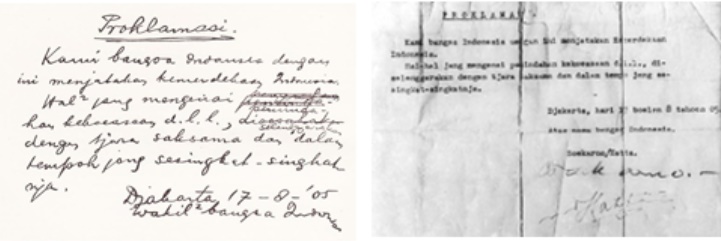
(credit: sumberbelajar.belajar.kemdikbud.go.id/)
The text of the Indonesian proclamation of independence, handwritten by Soekarno and typed by Sayuti Melik, is known to have differences as reported by the Ministry of Education and Culture, cagarbudaya.kemdikbud.go.id. The differences in the text of the Indonesian proclamation of independence after being typed are not too many. The changes are found in some words, sentences, as well as the writing of the date and month. The differences in the text of the Indonesian proclamation of independence after being typed are as follows:
- The first difference is in the word 'hal2' in the second paragraph of the first line, changed to 'hal-hal'.
- The second difference is in the word 'saksama' in the second paragraph of the second line, changed to 'tempo'.
- The third difference is in the previous writing of the date and month 'Djakarta 17-08-05', changed to 'Djakarta, hari 17 boelan 8 tahoen 05'.
- The fourth difference is in the sentence 'Wakil2 bangsa Indonesia', changed to 'Atas nama bangsa Indonesia'.
4. Meaning and Significance of the Proclamation of Indonesian Independence
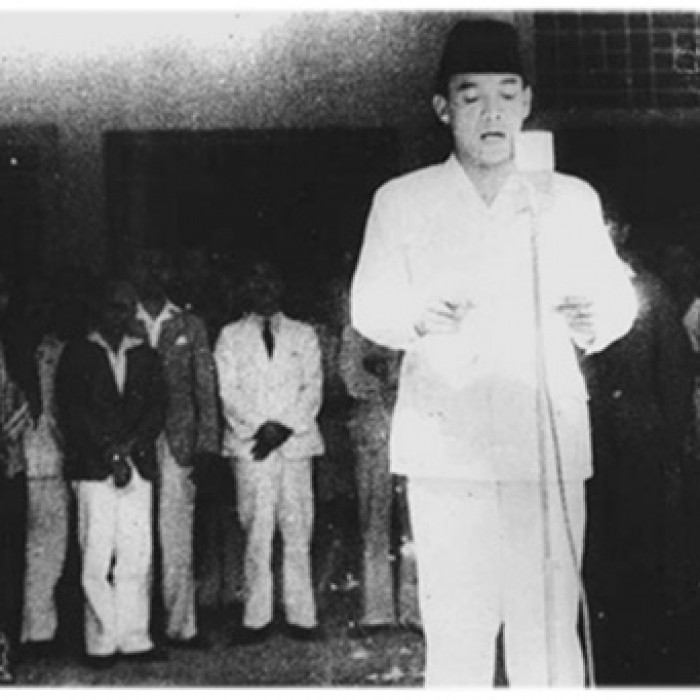
(credit: cagarbudaya.kemdikbud.go.id/)
There are several meanings and important meanings of the Indonesian declaration of independence. Here are some meanings and meanings of the Indonesian declaration of independence as quoted from the Ministry of Education and Culture website:
- It is the culmination or peak of the struggle of the Indonesian nation. It means that it is the culmination of the Indonesian nation's struggle against colonialism.
- It is the legal basis for the formation of the unitary state of the Republic of Indonesia. It means that it marks the formation of the Unitary State of the Republic of Indonesia.
- It is the beginning of the implementation of national law and the end of colonial law. It means that the previous colonial law imposed by the colonizers is replaced by national law.
- It is the starting point for the implementation of the people's suffering mandate. It means the beginning of the liberation of the people from poverty, oppression, ignorance, and forced labor.
That is the review of the history of the Indonesian declaration of independence text, its contents, formulation process, and meanings. By knowing the history and process of formulating the text of the Indonesian declaration of independence along with its contents and meanings, it can enhance the sense of nationalism and patriotism of the nation.
Source: p2k.unhamzah.ac.id, sumberbelajar.belajar.kemdikbud.go.id, cagarbudaya.kemdikbud.go.id
(kpl/nlw)
Disclaimer: This translation from Bahasa Indonesia to English has been generated by Artificial Intelligence.
